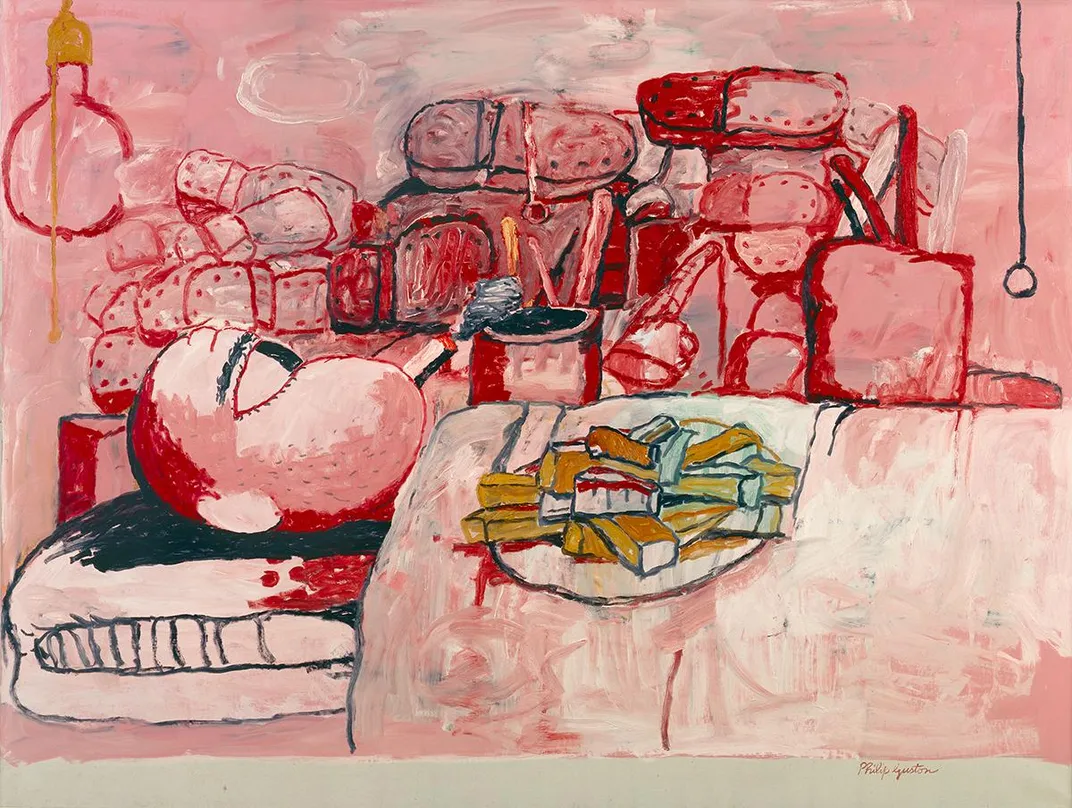Understanding the Controversy Over Postponed Exhibition Featuring KKK Imagery
A major Philip Guston retrospective scheduled to travel to D.C., London, Houston and Boston will now take place in 2024
:focal(2393x1327:2394x1328)/https://tf-cmsv2-smithsonianmag-media.s3.amazonaws.com/filer/e9/cb/e9cb3781-2062-49f3-8e7b-e5a6c03607e1/gettyimages-1037992336.jpg)
After a summer of racial unrest and protest on a scale not witnessed since the civil rights era, four prominent art museums have decided to postpone an exhibition that, depending on who is asked, would either exacerbate tensions or deepen understanding of the societal problem of systemic injustice.
Last week, the National Gallery of Art in Washington, D.C.; the Museum of Fine Arts in Boston; Tate Modern in London; and the Museum of Fine Arts in Houston announced plans to delay the opening of a long-awaited retrospective of artist Philip Guston until 2024, when its “message of social and racial justice … can be more clearly interpreted,” according to a statement.
Titled “Philip Guston Now,” the joint exhibition was slated to feature around 125 paintings and 70 drawings by the 20th-century Canadian American artist. At least 24 of these works contain “imagery that evokes” the Ku Klux Klan (KKK), report Julia Jacobs and Jason Farago for the New York Times.
The museums’ directors outlined the reasoning for the postponement in a September 21 announcement.
“We recognize that the world we live in is very different from the one in which we first began to collaborate on this project five years ago,” the statement explains. “The racial justice movement that started in the [United States] and radiated to countries around the world, in addition to challenges of a global health crisis, have led us to pause.”

Speaking with ARTnews’ Alex Greenberger, a representative for the National Gallery emphasized the risk of visitors misinterpreting Guston’s use of KKK imagery, adding that the backlash could end up overshadowing “the totality of his work and legacy, especially since it is known that Guston was an ardent supporter of racial equality and opponent of discrimination.”
Responses to the postponement ranged from outrage to understanding, with critics and curators alternatively decrying the decision as “cowardly,” “extremely patronizing” and “simply wrong.”
Robert Storr, author of the newly published biography Philip Guston: A Life Spent Painting, tells artnet News’ Sarah Cascone that now is the ideal time to revisit the artist’s work. The delay, he says, has “deprived us of the opportunity to reconsider the vexed social dimensions of art, and of our conflicted reality through the prism of the moral and political subtleties, purposefully provocative ambiguities, and searing satire of Guston’s prescient and profoundly disturbing work as a whole.”
In a statement provided to the Times, Guston’s daughter, Musa Mayer, says she is “saddened” by the decision, as her father’s work strives to grapple with racism head-on. Referencing Guston’s Jewish ancestry, she notes that his family fled Ukraine to escape persecution: In other words, he “understood what hatred was.”
Guston included images of the KKK in his work to try to make sense of racism, white complicity and social upheaval in the U.S., according to Ben Luke of the Art Newspaper. Though the artist had once relied on Abstract Expressionism to voice his creativity, he eventually turned to figuration as a way of exploring themes of white hegemony and domestic terrorism.
Guston works such as Riding Around (1969) depict distorted, cartoon-like figures performing everyday activities—including riding around in cars—while wearing Ku Klux Klan robes.
“[A]t once menacing and risible,” the hooded characters are simultaneously “frighteningly stupid and indelibly pathetic,” writes art critic Sebastian Smee for the Washington Post.
/https://tf-cmsv2-smithsonianmag-media.s3.amazonaws.com/filer/5f/24/5f24e983-662f-41e6-afce-c826bc80622a/archives_of_american_art_-_philip_guston_-_3028.jpg)
The debate surrounding Guston’s retrospective does not exist in a vacuum: In recent years, numerous museums have had to grapple with issues of racism and representation in visual art. One example of this occurred at the 2017 Whitney Biennial, where Dana Schutz’s painting of Emmett Till, a teenage boy who was violently lynched in 1955, sparked arguments that the artist was attempting to exploit black pain. This summer, the Museum of Contemporary Art Cleveland canceled an exhibition featuring Shaun Leonardo’s charcoal drawings of black and Latino men killed by police—a move the artist characterized as “an act of censorship,” reported Cascone for artnet News at the time.
Rather than canceling the Guston exhibition outright, the four museums say they want to put the works in a more well-rounded context, including bringing in “additional perspectives and voices to shape how we present Guston’s work at each venue,” representatives tell artnet News.
It’s worth noting, however, that the exhibition’s already published catalog arguably did just that, writes Luke for the Art Newspaper.
Citing the museums’ stated goal of achieving a clear interpretation by 2024, Trenton Doyle Hancock, an African American artist who contributed an essay to the catalog, asks the Art Newspaper, “Why haven’t institutions developed a deep and rounded cultural framing of Guston’s politics on American whiteness already?”
He concludes, “This conversation is happening whether institutions participate or not.”
/https://tf-cmsv2-smithsonianmag-media.s3.amazonaws.com/accounts/headshot/Isis_Davis-Marks_thumbnail.png)
/https://tf-cmsv2-smithsonianmag-media.s3.amazonaws.com/accounts/headshot/Isis_Davis-Marks_thumbnail.png)